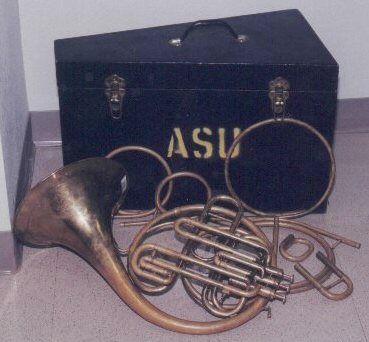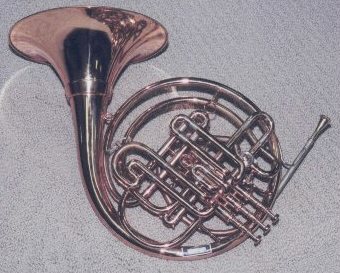
The Arizona State University Horn Studio
Information and resources for current
students, future students, and the horn world
Home -- Professor -- Horn Study -- Horn Articles Online
Piston Horns
 When I joined the ASU faculty I was curious to see what horns we had in the inventory. As someone very interested in early valved horns, I was especially excited to find a pair of piston valve horns.
When I joined the ASU faculty I was curious to see what horns we had in the inventory. As someone very interested in early valved horns, I was especially excited to find a pair of piston valve horns.
Perhaps the most interesting horn of the two is this Hawkes horn which has been dated to have been made around 1916. This horn takes crooks just like an orchestral natural horn and has crooks with it for E-flat, F, G, A-flat, and A with a short, 1/2 step coupler and short and long tuning slides. This is the type of valved horn used widely in England (and France) up until around W.W.II. It is in great shape. The bell and bore are very much like that found on the typical natural horn. The bell has a garland, and the tone is much more like that of the natural horn than that of a modern horn.
While it is fun to test, without a strap to assist in holding it I can't play this instrument for more than five or ten minutes at a time as a valved horn. The left hand position is quite uncomfortable; it has to do with the angle of the action of the pistons. On the plus side it plays well as a natural horn and the crooks work on both of my other natural horns. More information on actually playing on this horn may be found here. Crooked in F it sounds very much like a natural horn and in B-flat it has a sound that begins to get over toward the sound of a classic mellophone, which it also resembles.
 The other piston horn is this Selmer
double horn from roughly 1950. This was the type of
double horn widely used in France before roughly 1970, after piston
valve single horns like the Hawkes fell out of use. It is a compensating
double horn with a smaller bore than any other double horn I have ever seen, and is surprisingly heavy.
The other piston horn is this Selmer
double horn from roughly 1950. This was the type of
double horn widely used in France before roughly 1970, after piston
valve single horns like the Hawkes fell out of use. It is a compensating
double horn with a smaller bore than any other double horn I have ever seen, and is surprisingly heavy.
Like the Hawkes, this horn has its good and bad points. It has a very nice high range and it would be quite useful for a demonstration of French literature of the period. I had a very nice experinece playing the Villanelle on this horn. On the other hand, again, I can't play this horn for more than five or ten minutes before it just kills my left hand without a strap. With a strap it is tolerable. If it were all I had ever played it might feel a bit more comfortable.
I should also add a very postivie note that the legato is wonderful on both of these horns. Piston valves are extremely smooth in valve changes, with no "bumps" or "clicks."
I am often asked why piston valves are not used on valved horns today. Besides the already noted awkward action (really, awkward direction of action), for a double horn this design also requires extra long pistons (compared to those of say, a trumpet) which has got to also increase the cost. Piston valve horns are only rarely produced today
Return to the
ASU Horn Studio
School of Music, Arizona State University
Tempe, AZ 85287-0405
Phone: (480) 965-4152
Dept. Fax: (480) 965-2659.
E-Mail:
Alternate E-Mail: